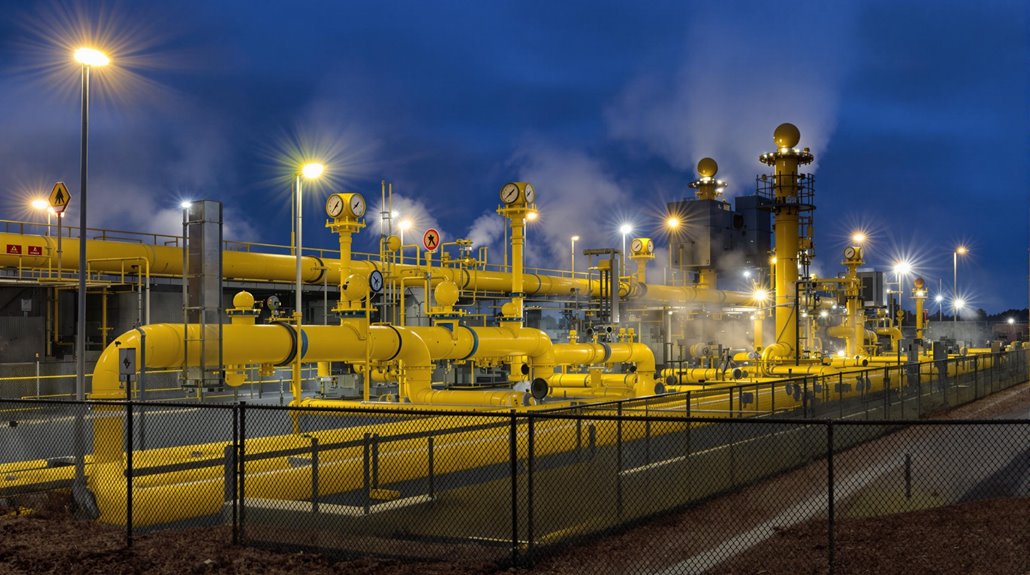How Is Natural Gas Stored for Later Use?
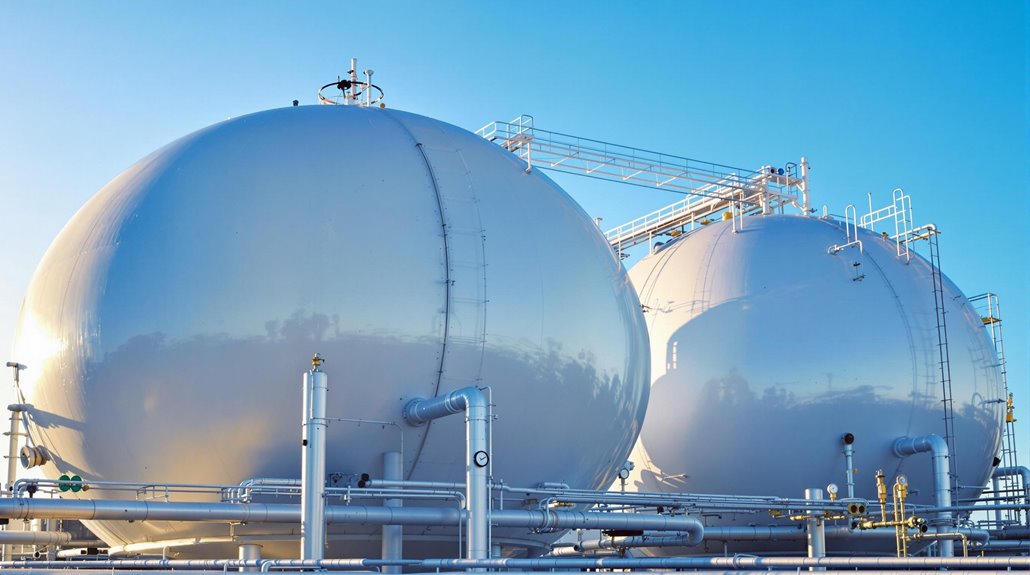
Natural gas is stored primarily in three types of underground facilities: depleted oil and gas fields, salt caverns, and aquifer reservoirs. You'll find that depleted fields make up about 90% of storage capacity, offering cost advantages from existing infrastructure. Salt caverns provide rapid withdrawal rates for peak demand periods, while aquifers serve as natural reservoirs. Companies also use specialized LNG tanks that can keep the gas at -260°F. Each storage method plays a unique role in ensuring reliable energy supply.
The Critical Role of Natural Gas Storage in Energy Security
Natural gas storage systems serve as the backbone of global energy security, providing essential flexibility in managing supply and demand. You'll find that underground storage facilities, including depleted oil and gas fields, salt caverns, and aquifers, make up most of the world's storage capacity.
When you're dealing with seasonal demand fluctuations, these storage systems act as indispensable buffers against supply disruptions. They'll help maintain steady production and transportation flows while stabilizing prices during peak usage periods. You can think of natural gas storage as an insurance policy for your energy needs.
That's why policymakers and industry leaders focus heavily on developing and maintaining strong storage infrastructure. It's a critical component that guarantees you'll have reliable access to natural gas, even when unexpected challenges arise in the supply chain. Similar to underground storage facilities used for protecting critical resources during emergencies, these systems are built to maintain the integrity of stored gas over extended periods.
Underground Storage Facilities: Types and Characteristics
Underground storage facilities form the foundation of our natural gas storage system, with three primary types dominating the terrain: depleted oil and gas fields, salt caverns, and aquifer reservoirs.
When you're looking at how gas is stored underground, depleted gas reservoirs offer the most cost-effective solution. They'll let you use existing infrastructure while requiring less base gas to maintain pressure. Salt cavern storage facilities provide you with superior withdrawal and injection rates, though they'll cost more to develop. Meanwhile, aquifer reservoirs, while viable options for underground natural gas storage, need more base (cushion) gas and don't offer the same operational flexibility as other types.
You'll find these storage facilities strategically placed near major consumption areas, ensuring there's enough gas storage capacity to meet your seasonal demand fluctuations. Similar to how water storage locations require cool, dark environments for optimal preservation, natural gas storage facilities must maintain specific temperature and pressure conditions.
Depleted Fields: Repurposing Natural Resources

When you're looking for a practical way to store natural gas, depleted oil and gas fields stand out as the industry's go-to solution. These underground storage facilities account for up to 90% of total storage capacity, making them the most prevalent option for natural gas storage.
You'll find that depleted fields offer significant cost advantages since they come with pre-existing infrastructure, including wells, gathering systems, and pipeline connections. The process involves re-injecting working gas into these formations, while maintaining a certain amount of cushion gas to guarantee proper pressure. While deliverability rates for withdrawal and injection are lower compared to other storage types, depleted fields require less base gas requirements to operate effectively.
Regular monitoring verifies these repurposed reservoirs maintain their integrity and continue providing reliable storage capacity for years to come. Similar to how wood fuel storage provides reliable energy availability during supply disruptions, depleted gas fields ensure consistent access to natural gas when demand increases.
Salt Cavern Storage: High-Performance Solutions
A high-performance alternative to depleted fields lies in salt cavern storage facilities, which deliver unmatched operational flexibility for natural gas storage needs. You'll find these facilities offer high deliverability with withdrawal and injection rates up to 10 times faster than depleted reservoirs.
Salt cavern storage requires crucially less cushion gas, using only 20-30% of total capacity compared to 50-70% in depleted reservoirs. This efficiency makes them ideal for meeting peak demand periods, as you can cycle gas in and out frequently. To create these storage spaces, operators use solution mining to dissolve and extract salt from underground salt deposits. While the development costs are higher, you'll benefit from superior operational flexibility and reliability.
Salt caverns prove especially crucial when you need rapid response times and frequent access to stored natural gas. Like underground bunkers, these facilities require structural integrity checks to ensure long-term stability and safety of the storage system.
Aquifer Storage: Utilizing Natural Water Formations
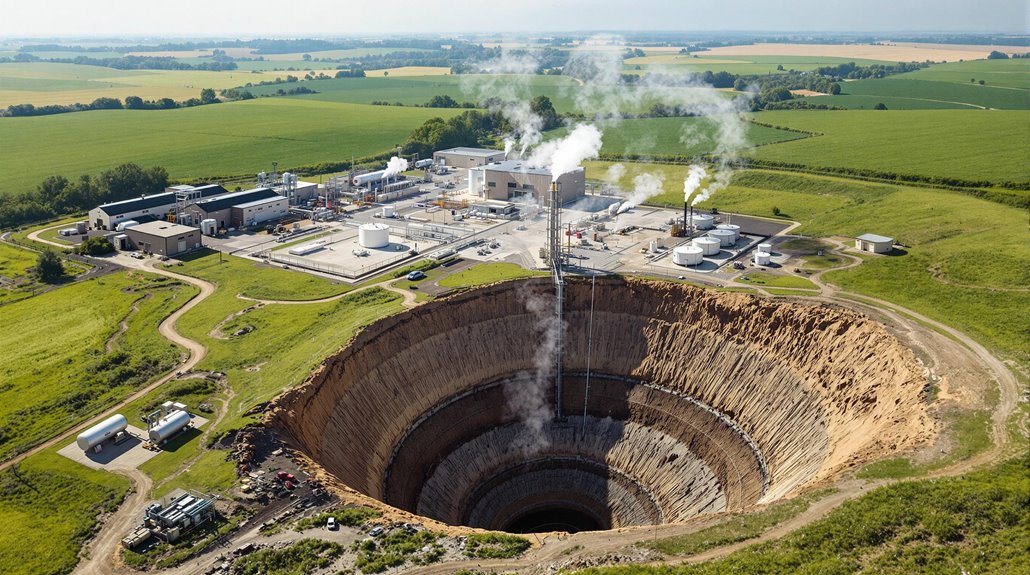
Natural water-bearing formations provide another viable option for storing large volumes of natural gas underground. When you're looking to use aquifer storage, you'll need to start with a thorough geological evaluation of the sedimentary rock formations to guarantee they can effectively contain and release gas.
You'll find that aquifer storage requires more base gas compared to other underground options, which impacts your operational flexibility. The process of gas injection and withdrawal must be carefully managed, as these natural formations weren't originally designed to hold gas. You'll need to implement extensive monitoring systems to detect any potential leaks or integrity issues that might arise. While it's not as common as other storage methods, aquifer storage can substantially increase your natural gas storage capacity when suitable formations are available.
LNG Storage Technologies and Applications
Unlike underground storage methods, liquefied natural gas (LNG) storage offers you above-ground solutions for managing large gas volumes. You'll find specially designed insulated tanks that maintain temperatures around -260°F, keeping the natural gas in its liquid state. These storage tanks can hold millions of gallons, providing essential seasonal storage to meet fluctuating natural gas demand.
The liquefaction process makes storage exceptionally efficient by reducing gas volume over 600 times. This means you're getting substantially more storage capacity in a smaller footprint. Storage facilities often combine LNG storage applications with underground natural gas storage to create a flexible, reliable supply system. This combination helps you maintain consistent gas availability throughout the year, especially during peak demand periods when you need additional capacity.
Seasonal Demand Management Through Storage
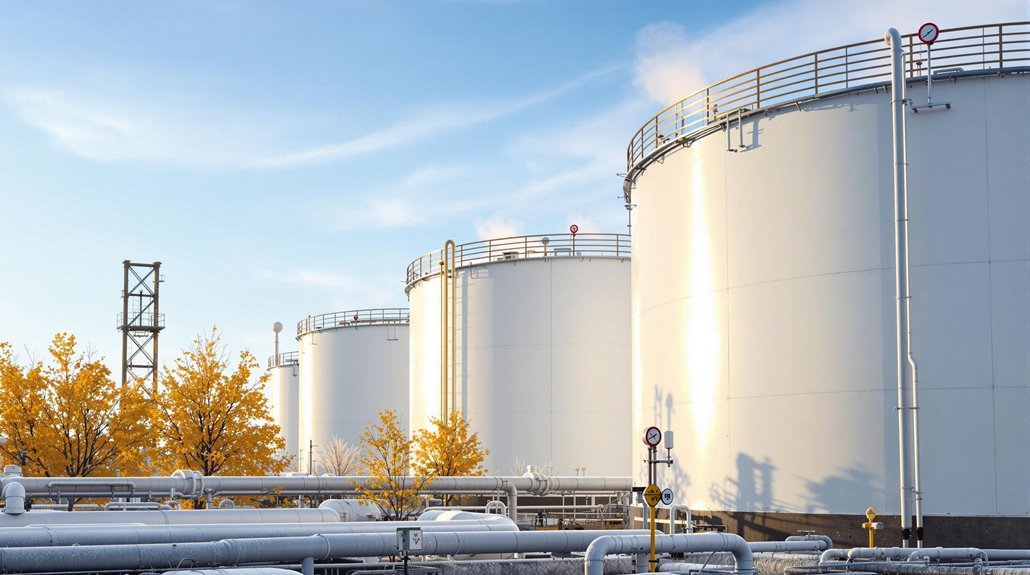
Because demand for natural gas fluctuates noticeably throughout the year, storage facilities play a critical role in maintaining reliable supply. You'll find underground storage systems like depleted fields, salt caverns, and aquifers working together to manage seasonal demand patterns, with working gas being injected during low-demand periods and withdrawn when consumption peaks.
- It keeps your heating costs stable during frigid winter months
- It guarantees your air conditioner runs reliably during summer heat waves
- It safeguards you from price spikes when demand surges
The U.S.'s 4 trillion cubic feet of storage capacity acts as a buffer between production and consumption. During shoulder months, operators inject excess gas into these facilities, while withdrawal rates increase considerably during peak winter heating and summer cooling seasons.
Storage Facility Operations and Maintenance
Managing these massive storage facilities requires constant monitoring and specialized knowledge. You'll find that storage operators must carefully track gas volumes as they're injected and withdrawn to maintain proper pressure levels within underground caverns and reservoirs.
Regular maintenance of surface equipment, including compressors, pipelines, and monitoring systems, is essential for safe operations. When you're dealing with salt cavern storage, you'll need to pay special attention to cavern integrity during injection cycles, as pressure changes can affect the formation's stability.
Facility operators conduct routine inspections, test safety systems, and monitor for potential leaks or structural issues. They'll also maintain detailed records of all operations, including gas flow rates, pressure readings, and equipment performance. This data helps guarantee the storage facility remains reliable and operates at peak efficiency year-round.
Economic Considerations in Natural Gas Storage
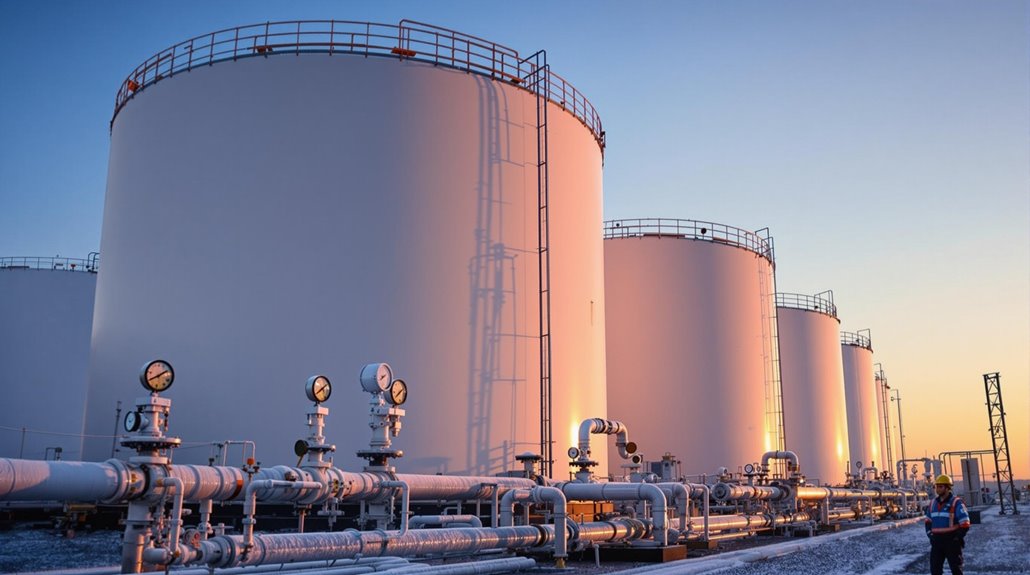
Natural gas storage comes with hefty financial implications that shape investment decisions and operational strategies. When you're assessing storage investments, the high construction costs and capital intensity can make or break a project's viability. Gas is injected and prized differently based on facility type, with depleted formations typically being more cost-effective than salt caverns per thousand cubic feet of capacity.
Three key economic factors you'll need to contemplate:
- Base gas requirements, which can reach millions of dollars per thousand cubic feet, especially in aquifer formations
- Seasonal price spreads that affect when you'll inject or withdraw Natural Gas to meet demand
- High-deliverability storage options that provide influential flexibility during peak demand periods
The economics vary substantially based on whether you're dealing with regulated storage or LDC facilities, impacting your valuation approach and investment decisions.
Environmental Impact and Safety Measures
Storage facilities must step up to meet rigorous environmental and safety standards that protect both ecosystems and nearby communities. Before construction begins, detailed risk assessments evaluate potential environmental impact and determine necessary safety measures. You'll find that geological stability plays an indispensable role in selecting underground storage sites, where continuous monitoring systems track pressure changes and potential gas migration.
Well integrity testing ensures the structural soundness of storage facilities, while containment systems in above-ground LNG tanks provide multiple layers of protection. You can rest assured that extensive emergency response plans are in place to address any potential incidents. Regulatory compliance is strictly enforced through regular inspections, focusing on both environmental protection and workplace safety. These measures work together to minimize risks and maintain the facility's safe operation.


